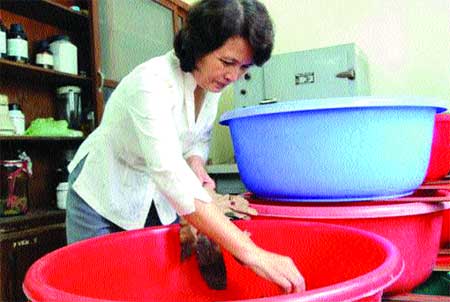

People call Hoang Ngoc Anh a "scorpion doctor" because she found a way to produce pain reduction cream using their venom.
The researcher at the Viet Nam Academy of Science and Technology's Institute of Material Science has been fascinated by insects since she was a young girl. Born in the former imperial city of Hue, Anh grew up in Ha Noi, where she excelled at chemistry. After graduating high school in 1969 with high marks, she was sent to study chemistry at the Tashkent University, Uzebekistan.
She thought that different kinds of poisons would be an interesting subject for a PhD thesis because poisonous insects were everywhere in tropical Viet Nam.
After defending her thesis and returning to Viet Nam in 1989, her passion for researching poisonous insects brought her to many locations in southern provinces. When she returned to Ha Noi, she brought home a dozen brown scorpions.
"I wanted to do research on them, but did not know how to take the scorpions' poison out," Anh recalled.
She used French documents to come up with a design for a machine that could do this. Under her direction, the first machine was produced by the Chemistry Department's Structure Office. After that Anh continued to build a process to collect and preserve poisons, co-operating with the Institute of Ecology and Resources.
But during the 1990s, when Viet Nam was facing many difficulties, scientists lacked information and resources for research. Experts at the Institute of Ecology and Resources couldn't make a proper name for Anh's brown scorpions, she recalled.
In 2003, she sent a sample scorpion to famous French classification expert A. Lorenco of the Paris Museum of Nature to make a scientific name for them.
"The professor named my brown scorpions Lychas mucronatus," said Anh.
She began raising scorpions to extract their poisons but many of them died because of the unsuitable climate in Ha Noi. So she decided to move to the southern province of Binh Phuoc. After two months, she raised more than 3,500 scorpions.
"First I raised them in a group in a small box, but I learned that in daylight they killed each other. So I put them into large plastic basins and covered them with dried leaves and fresh grasses," she said.
She also fed them crickets and grasshoppers. According to her, 500 scorpions could eat 1kg of crickets, and the important thing was not to let them get hungry, or they would eat each other.
The work was also not without its dangers for Anh herself. When she was bitten by a scorpion, her right hand was paralysed for half a day. But the inveterate researcher found opportunity even in suffering.
"It forced me to research how to produce a cream to reduce the pain of such bites," Anh said.
Undaunted, she continued her work, moving her family to HCM City in 2006 because the climate was suitable for scorpion breeding and research. The following year, she submitted a research project on using the poisons of grown scorpions for anti-inflammatory and pain reduction medicine to the HCM City Department of Science and Technology for approval.
It was approved and a trial produced 1,000 tubes of cream which were effective in pain reduction, said Le Quan Nghiem, chairman of the Scientific Appraisal Council.
"I hope we can produce the cream on a large scale. It will sell at an affordable price compared with imported items such as Escozine," Nghiem said.






